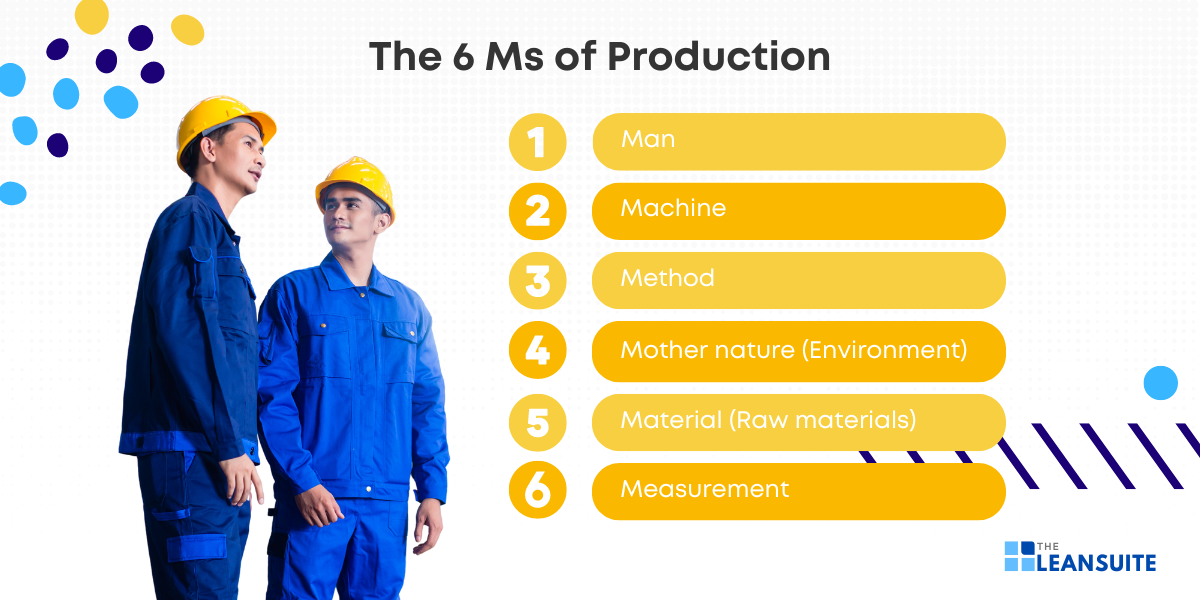Navigating the intricate world of production management can often feel like decoding a complex puzzle. One of the most effective frameworks to simplify this process is the 6 Ms of production: Man, Machine, Method, Mother Nature, Material, and Measurement. These six key factors play a crucial role in shaping the efficiency, quality, and success of any production process. In this blog post, we will explore each of these components, exploring how they interact and contribute to creating a streamlined, effective production environment.
What are the 6 Ms of production?
The 6 Ms of production is a comprehensive framework used in manufacturing and other industries to categorize the different inputs that could potentially cause quality problems within processes. The six categories are Man, Machine, Method, Mother Nature, Material, and Measurement.
Understanding the 6 Ms is essential for conducting effective root cause analysis and driving quality improvements. By breaking down the process inputs into these six categories, teams can systematically investigate and address the factors that may be contributing to defects or inefficiencies. This structured approach helps in pinpointing the exact sources of problems. Therefore, making it easier to implement targeted solutions.
While the 6 Ms are primarily associated with manufacturing, their application extends beyond the factory floor. In fact, they can be utilized in various functional areas such as marketing and other non-manufacturing processes. By employing the 6 Ms framework, manufacturers can improve their overall operational efficiency and quality across different sectors.
Understanding the 6 Ms
The 6 Ms of production are important factors in the manufacturing process that must be carefully managed to ensure efficiency, quality, and consistency.
By carefully managing the 6 Ms of production, manufacturers can achieve greater consistency, higher quality, and improved efficiency in their operations. Each element plays a pivotal role in the overall success of the manufacturing process and requires ongoing attention and optimization.

1. Man (People)
“Man” refers to the human element involved in the manufacturing process. In essence, this includes the workers, operators, engineers, and managers who play an essential role in ensuring the smooth operation of production activities.
Human factors can introduce variation in the process through differences in skill levels, experience, and even fatigue. For example, an experienced worker might perform a task more efficiently and with fewer errors than a novice. Likewise, human error can lead to defects or inconsistencies in the final product.
To minimize such variations and improve quality, it is important to invest in comprehensive training programs, ergonomic work environments, and effective communication channels. By encouraging a culture of continuous improvement and teamwork, this can also help in harnessing the potential of the human workforce effectively.
2. Machine
“Machine” refers to the mechanical and technological equipment used in the production process. Variations in machine performance, such as normal wear and tear in manufacturing environments, can significantly impact the quality and consistency of products. What’s more, over time, equipment can degrade. As a result, this can lead to deviations in process outputs, impacting overall process performance.
Regular maintenance is crucial to minimize machine variation and ensure quality improvement. By implementing a robust preventive maintenance schedule, manufacturers can detect and address potential issues before they become major problems. Additionally, by investing in modern, high-quality machinery, this can reduce downtime and improve operational efficiency. Real-time monitoring systems can also be employed to track machine performance and predict maintenance needs. Thereby, minimizing disruptions in the production process.
3. Method
The “Method” category encompasses the procedures, workflows, and work instructions used in production and transactional processes. Variations in methods can lead to quality problems and negatively affect process performance. For instance, if different workers follow different procedures for the same task, the resulting products may differ in quality.
To minimize method variation, it is essential to standardize work instructions and ensure that all employees follow the same procedures. Comprehensive training programs and detailed documentation can help achieve this standardization. Additionally, periodic audits and process reviews can identify areas for improvement and ensure that best practices are consistently applied.
4. Mother nature (Environment)
“Mother Nature” refers to environmental factors that can influence the production process. This includes elements such as temperature, humidity, and weather conditions, which can all cause variations in production outcomes. For example, fluctuations in temperature can affect the properties of raw materials, while high humidity levels may impact the drying process in certain manufacturing activities.
To mitigate these effects, it is important to monitor environmental conditions closely and implement controls to maintain stable production environments. This might involve using climate-controlled facilities, employing dehumidifiers, or scheduling production activities to avoid extreme weather conditions.
By understanding and managing the impact of environmental factors, manufacturers can reduce variability in their processes and improve overall product quality.
5. Material (Raw materials)
The “Material” aspect deals with the raw materials and components used in manufacturing. Variations in material properties, such as consistency, purity, and quality, can lead to differences in the final product. For instance, if the raw materials are of poor quality or inconsistent, the end products may not meet the desired specifications.
To minimize material variation, it is crucial to establish strong relationships with reliable suppliers and implement rigorous quality control measures. This includes conducting thorough inspections and testing of incoming materials to ensure they meet required standards. Additionally, maintaining proper storage conditions for raw materials can prevent degradation and contamination.
By ensuring the consistency and quality of materials, manufacturers can produce higher-quality products and reduce the likelihood of defects.
6. Measurement
“Measurement” refers to the methods and tools used to assess and verify the quality and performance of the production process. Variations in measurement techniques or inaccuracies in measurement tools can lead to incorrect assessments and affect overall process control. For example, if a measuring instrument is not calibrated correctly, it may provide inaccurate readings. Thus, leading to faulty products.
To minimize measurement variation, it is essential to use precise and reliable measurement tools and ensure they are regularly calibrated and maintained. What’s more, implementing standardized measurement procedures and conducting regular audits can also help ensure consistency and accuracy.
By focusing on precise measurement practices, manufacturers can better control their production processes. Therefore, ensuring that products meet the required quality standards and specifications.
Applying the 6 Ms to root cause analysis
Applying the 6 Ms of production to root cause analysis is a powerful approach to identifying the root cause of quality problems in production processes.
By examining each of these categories, organizations can systematically uncover the underlying issues that lead to process variations and defects. Moreover, the 6 Ms provide a structured method for dissecting and analyzing problems, ensuring that all potential factors are considered.
This framework is not limited to manufacturing alone; it is versatile enough to be applied across various functional areas, including marketing and non-manufacturing processes. By leveraging the 6 Ms, businesses can gain a comprehensive understanding of their operations. As a result, this can lead to effective solutions and continuous improvement.
Best practices for effective root cause analysis
Effective root cause analysis is crucial for identifying and addressing the underlying issues in any process problem. To begin with, it’s beneficial to use the 6 Ms of production as a framework to pinpoint potential root causes. Essentially, this comprehensive approach ensures that no aspect of the process is overlooked.
Visual tools like a Fishbone Diagram, also known as an Ishikawa or Cause-and-Effect Diagram, can help map out and visualize the intricate relationships between various process elements and their potential root causes. Thereby, making it easier to understand complex interactions. Additionally, it’s important to consider all process inputs and environmental factors that might influence process performance. This is because these can often be the hidden contributors to problems.
Finally, an impact difficulty matrix can be a valuable tool to prioritize the identified potential root causes. By evaluating and focusing on the issues that have the highest impact and are the most feasible to address, teams can efficiently allocate their resources and efforts to resolve the most critical problems effectively.
Common applications and benefits of the 6 Ms
The 6 Ms of production are integral to various manufacturing processes, including assembly line production and facility systems. These six factors provide a comprehensive framework for identifying root causes of quality problems. Therefore, enabling businesses to pinpoint inefficiencies and areas for improvement within their operations.
By systematically examining each of the 6 Ms, companies can enhance their quality improvement initiatives, reduce process variation, and ultimately achieve higher levels of performance and consistency. This structured approach not only fosters a culture of continuous improvement, but also ensures that every aspect of the production process is optimized. Thus, leading to better product quality and increased customer satisfaction.
Conclusion
The 6Ms of production provides a comprehensive framework for effective root cause analysis and quality improvement in manufacturing processes. Understanding these elements is essential for identifying the root causes of quality problems and enhancing process performance. By applying the 6 Ms to root cause analysis, organizations can significantly improve their quality improvement initiatives and reduce process variation.
In summary, the 6 Ms of production provide a valuable framework for categorizing process inputs and identifying potential causes of quality issues. This understanding is pivotal for achieving continuous improvement and maintaining high standards in any industry.





